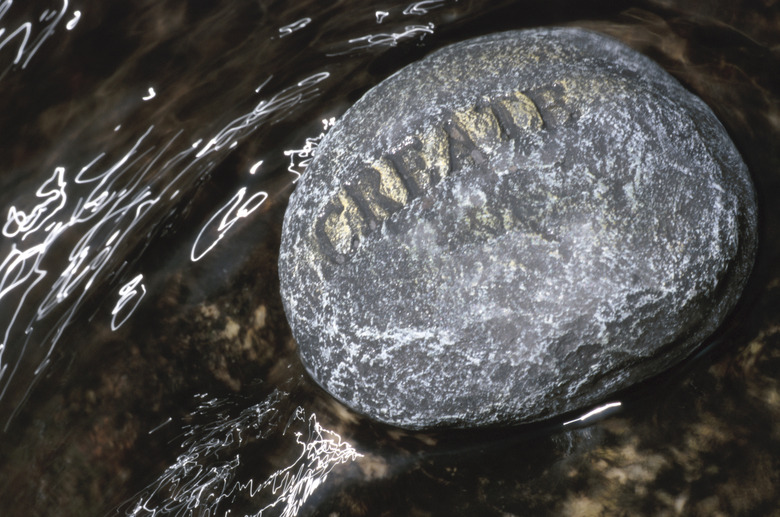Tools For Rock Engraving
Rock engraving is one of the oldest human endeavors, dating back at least 77,000 years. The permanence of stones turns engravings into solid decorative items, signs, memorials and tomb stones. Technology has changed the way rock engraving is accomplished, but the process is also possible with primitive tools. Today, there are numerous techniques available to anyone with an interest in this specialized field.
Sandblasting
Sandblasting
Modern rock engraving is most easily accomplished using sandblasting. While the use of sandblasting machines predates the twentieth century, they did not catch on for widespread rock engraving until after 1930. The mechanics of a sandblaster are simple. Small particles of sand are shot towards a rock, gradually wearing away its surface. The sand can be ejected by compressed air or steam, and the fine particles allow for precision in any engraved design or lettering. As there is little physical effort involved, the engraver can complete a project more quickly than older methods. Sandblasters vary in size depending on the type of project. Small custom engraved stones are frequent gifts, and engravers use sandblasters as small as an ink pen to create these items.
Stencils
Stencils
Just as sandblasting has streamlined the process of carving into rock, so too has technology significantly improved the process of creating and applying engraving patterns to stone surfaces. Stencils are the most popular method for laying out a rock engraving design prior to sandblasting. Modern devices can transfer hand-drawn or photographic designs to an adhesive which is directly applied to the engraving object. These stencils can involve considerable detail and miniaturization without complicating the engraving process. Once applied, a stencil forces the sandblaster to only cut through the design outlines, leaving the rest of the stone surface untouched. The results are dazzling, as even the most intricate photographs can be easily etched onto hard surfaces with this technique. Often, computer software is involved to broaden the creative options in any stencil design.
Burin
Burin
Some modern engravers still use older methods that pre-date the widespread use of sandblasting. A burin is a steel tool developed to cut into rock and other hard surfaces. It was a common item in the artisan's toolkit for hundreds of years, and early forms of print publishing also used burins to create templates for mass copying. The engraver would carve directly into the rock using the burin, and the process was long and painstaking. The burin concept is still in use today, but modern burins are more technologically advanced. Instead of a solid-state tool that works similar to a knife, today's burins have pulsating tips that can vibrate into a rock thousands of times per minute. They relieve the physical pressure on the engraver and speed up the overall process.
Cite This Article
MLA
Highland, James. "Tools For Rock Engraving" sciencing.com, https://www.sciencing.com/tools-rock-engraving-5780484/. 24 April 2017.
APA
Highland, James. (2017, April 24). Tools For Rock Engraving. sciencing.com. Retrieved from https://www.sciencing.com/tools-rock-engraving-5780484/
Chicago
Highland, James. Tools For Rock Engraving last modified March 24, 2022. https://www.sciencing.com/tools-rock-engraving-5780484/
